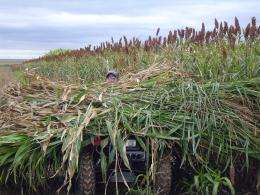Forage silage alternatives sought in wake of drought

Silage worries have producers asking a lot of questions as spring planting nears, according to a Texas AgriLife Extension Service specialist.
Dr. Brent Bean, AgriLife Extension agronomist, said he’s been getting a lot of calls from producers, dairymen and others who found themselves lacking good roughage sources last year for their cattle.
“Most of the industry relies on corn silage, which did not do well last year during our extreme drought and high temperatures,” Bean said. “The industry is now looking for an alternative crop that uses less water and can tolerate high temperatures.”
As a result, he said, many are looking at forage sorghum. Although forage sorghum may not yield as much as corn under full irrigation, it requires about 30 percent less water than corn and is more heat tolerant.
Bean said he has conducted forage sorghum silage trials in the Panhandle for many years and has recently summarized results from the last four years. The results of those trials can be found at amarillo.tamu.edu under the agronomy program tab.
While the primary interest this year appears to be quantity, he said producers should not ignore quality, especially on silage for dairy operations.
Bean said he has included in his summary of varieties some indicators of quality, such as digestibility and estimated pounds of milk produced per ton of forage.
The varieties in Bean’s trials were planted in late May on 30-inch rows at a seeding rate of 100,000 seeds per acre. Harvest started on early maturing varieties in late August and continued through mid-October on late-maturing varieties.
All the forage silage yields are reported at 65 percent moisture, he said. The varieties that consistently yielded above the test mean, had low lodging scores and were not photoperiod sensitive were: AS781, SS405, 849 F, 9500, FS-5, Millennium BMR, BMR Gold X and HiKane II. Two other varieties, Silo 700D and HP 95 BMR, finished above the test mean in two of the four years tested.
The average yield over a four-year period was 20.5 tons per acre, with a range from 18.4 tons to 26.8 tons per acre, Bean said. Eighteen varieties consistently yielded above the annual test average at least two-thirds of the time.
Lodging is an important issue in sorghum silage production and can vary greatly from year to year depending on the conditions, he said. Of the 18 best-yielding varieties tested, six had lodging scores of greater than 15 percent. If these varieties are planted, producers should plant a lower seeding rate and make sure the field is not over-fertilized with nitrogen to help prevent lodging.
“In addition, it is important that these varieties are harvested as soon as they reach the proper moisture, which is usually at soft dough stage,” Bean said. “Delaying harvest past the optimum time can lead to increased lodging.”
Provided by Texas A&M AgriLife

















